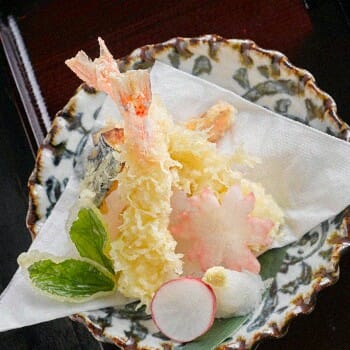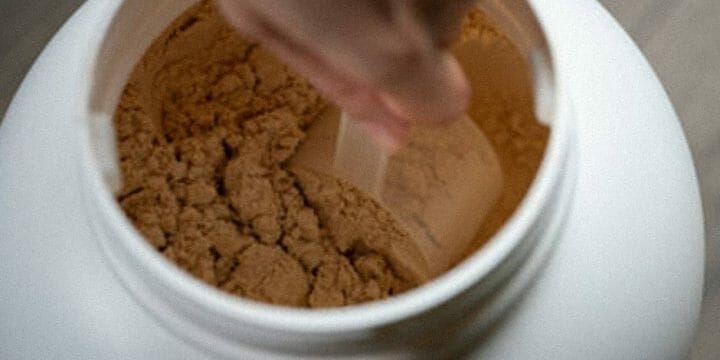From my own kitchen adventures, I've found tempura to be a delightful, light, and crispy batter that's perfect for coating everything from my garden's veggies to occasional seafood treats.
While most people worry about what's inside the batter, is the tempura batter itself actually vegan?
I checked what the online information says, and talked with our dietician to learn everything about tempura.
Let's take a closer look at is tempura vegan.
Quick Summary
- Tempura can be vegan provided it is egg free as long as you avoid seafood.
- The traditional vegan tempura ingredients used during preparation are wheat flour, sparkling water, and rice flour.
- According to TasteWise, vegetable tempura is consumed 1.17 times every year on average.
- Personally, I find that vegan tempura, when made with the right ingredients, can be just as crispy and flavorful as the traditional version.
What Is Tempura?

Tempura is a dipping dish from Japan dating back hundreds of years. It is a light and fluffy batter that provides an excellent flavor and a satisfying crunch.
It is less dense than other batters and, while still quite oily, doesn't feel as typically heavy or bad
It's trendy in the West, and you'll find it as a staple menu item at Japanese and other restaurants alike.
Typically, it's served as a coating around fish, but broccoli, asparagus, bamboo shoots, and many other vegs are equally popular.
Regional Variations of Tempura
Originally introduced to Japan by Portuguese traders, tempura has since been adapted and reimagined in countless ways.
In Japan, the Kanto and Kansai regions present distinct styles. Kanto-style tempura, popular in Tokyo, often features a light, thin batter, allowing the natural flavors of the ingredients to shine.
Kansai-style tempura, found in Osaka, typically uses a slightly thicker batter, creating a heartier texture.
While seafood is a common ingredient in both styles, there's a growing trend in urban areas to incorporate a wider range of vegetables, catering to the vegan palate.
Outside Japan, tempura has taken on new forms. In Western countries, adaptations might include non-traditional vegetables and even vegan mock seafood, expanding the dish's appeal to a broader audience.
Is It Vegan?
Based on my research, I've learned that, as a general rule even vegetable tempura is often not vegan.
In the West, this is because the batter most likely contains eggs unless you're at a vegan restaurant.
In Japan, the batter is straightforward and only really calls for sparkling water and weak flour, but it's always best to check.

Tempura as a dish is famously a coating for seafood, whether shrimp, fish, or squid.
Traditionally the vegetables are usually served alongside the seafood, not as the primary focus.
It will be simple to avoid ordering seafood tempura on most Western menus, but be aware of this if you do end up ordering it abroad.
From a personal standpoint, I always consider whether I'm okay with my vegetable tempura being fried near or in the same oil as seafood tempura, especially when dining out.
Ingredients
The traditional recipe for deep-fried crispy tempura has a straightforward ingredients list. It focuses on high-quality ingredients and not too much filler.
In my research, I've found that the essential ingredients are simple: wheat flour, rice flour, and sparkling water.
This means the most authentic tempura recipes are also vegan recipes.
That said, in the West, eggs are far too often used, and you should always check to make sure with your waiter. While authentic vegetable tempura should be vegan default, you still always, unfortunately, have to check.
Always Check the Dipping Sauce
Even if you are sure you're ordering plant-based tempura, it's a good idea to check the ingredients for the dipping sauce.
While the batter might contain animal products such as eggs, the dip is prone to having seafood incorporated into it like dashi flakes.
Fish sauce is also a common ingredient in dipping sauces, which is why chef Freya Drake of Kitchen Ambition advises checking the ingredients or asking the server first to make sure that the sauce is vegan.
I've had times when the dipping sauce wasn't plant-based, but I quickly learned that a simple mix of soy sauce and chili flakes can be a brilliant substitute.
Is Restaurant Tempura Vegan?
Here's what you should do if eating tempura in a restaurant:
- The first thing you should do is let your waiter know you're vegan so they can make recommendations and accommodations for you.
- With tempura, the first thing you'll want to check is the batter. Ask if they use eggs or just wheat flour and water.
- If the dish isn't explicitly labeled as vegetable tempura and comes with a variety, ask what comes with it to make sure you don't accidentally order seafood.
- Check that the dipping sauce is vegan, and if not, ask if there is a replacement.
Homemade Vegan Recipe

From my experience, making vegan tempura at home is the best way to ensure quality and taste, plus it's a fun cooking adventure.
You get to use the perfect vegetables, your favorite oil, and you can even craft the ultimate vegan dip.
When cooking tempura at home, the biggest problem you'll likely face is deep enough deep fry and the proper utensils to fish your fried vegetables out.
One thing I like most about doing this at home, though, is using our oil. Even a little bit of sesame gives such a rich umami flavor to the traditional Japanese dish.
When choosing the right vegetables for our vegan tempura cooking, make sure they have a decent crunch as well as a chew. Broccoli and asparagus are perfect for those reasons, but any of your favorite veggies will add something special.
Store-Bought Vegan Tempura Batter
As mentioned above, traditionally, tempura batter should be plant-based. If you're looking for a Japanese mix to use for home cooking, be sure to keep an eye out that it is egg-free.
At home, I usually keep a stock of Kikkoman Extra Crispy Tempura Batter, which goes to prove that tempura doesn't need an egg to be delicious, light, and fluffy.
It's great for surprising guests with something that is surprisingly easy to mix and make while also giving the impression of something exotic and exciting.
If you don't have the time to be making your batter mix from scratch, there are lots of great Japanese-inspired tempura to cook at home. And, the batter you choose can largely change the dish texture according to a study in MDPA Journal [1].
Nutritional Profile of Vegan Tempura
Vegan tempura is not only a delicious alternative to its traditional counterpart but also offers a unique nutritional profile that can be beneficial for those following a plant-based diet:
- Caloric content: Vegan tempura is lower in calories compared to traditional tempura. The absence of eggs and seafood in the batter reduces the overall calorie count, making it a lighter option.
- Macronutrients: Vegan tempura is predominantly carbohydrate-based, especially when made with vegetables like sweet potatoes, zucchini, or bell peppers. The batter, typically made from wheat flour, contributes to the carbohydrate content.
- Fiber: Vegetables used in vegan tempura are excellent sources of dietary fiber, essential for digestive health. They also provide vitamins such as Vitamin A, C, and K, and minerals like potassium and magnesium.
- Healthy fats: While traditional tempura often contains cholesterol and saturated fats from seafood and eggs, vegan tempura is free from these. Using heart-healthy frying oils like canola or sunflower oil can add beneficial unsaturated fats.
Plus, according to a study MDPI Journal, tempura is rich in antioxidant properties [2].
Related Articles:
- Can Vegans Eat Nutter Butters?
- Is Tahini Suitable for Vegans?
- Is Maple Syrup Suitable for Vegans?
- Is Popcorn Suitable for Vegans?
References:
1.https://www.mdpi.com/2304-8158/9/5/626
2. https://www.mdpi.com/2304-8158/9/9/1246
About The Author
You May Also Like






